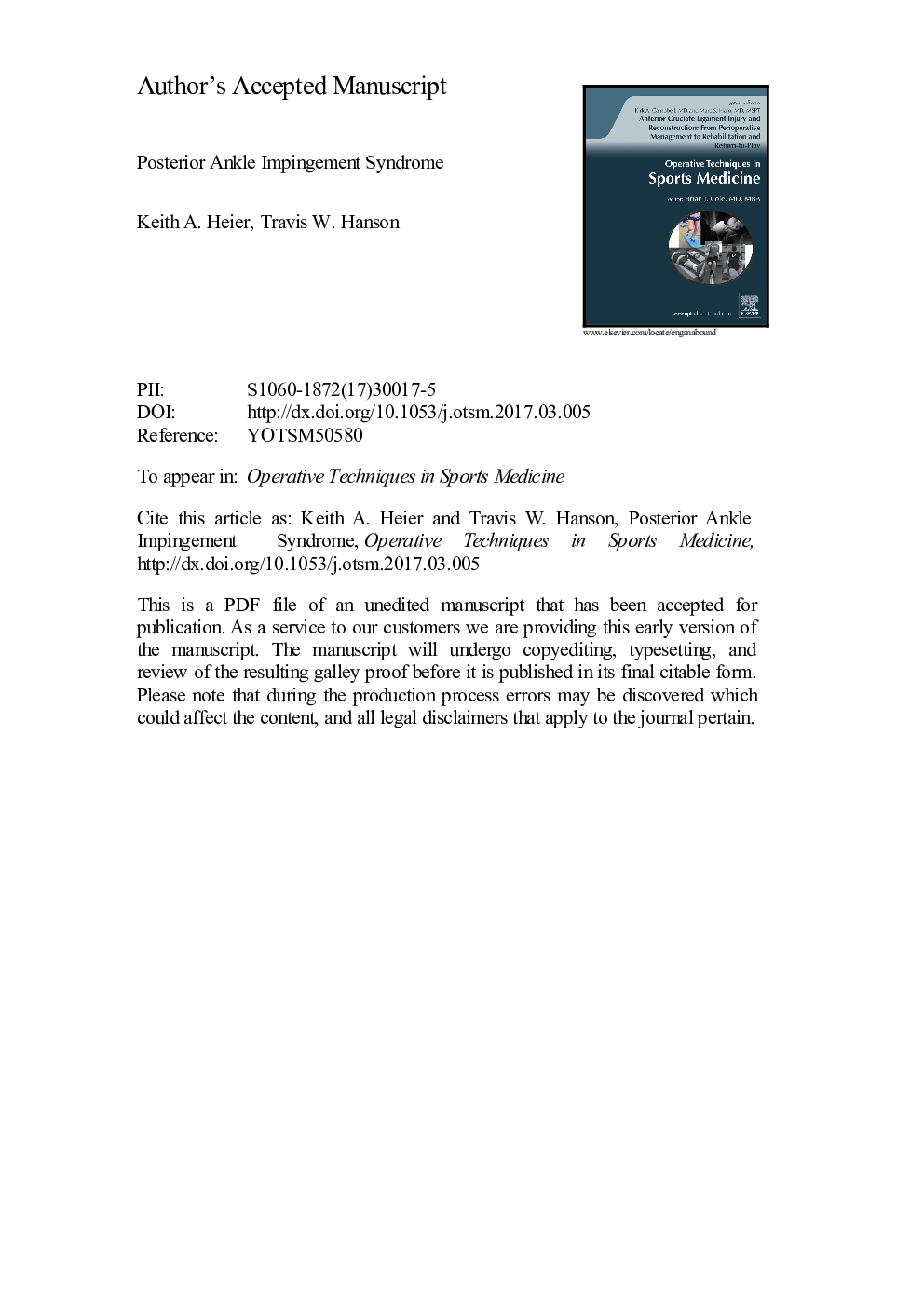| کد مقاله | کد نشریه | سال انتشار | مقاله انگلیسی | نسخه تمام متن |
|---|---|---|---|---|
| 5710949 | 1410912 | 2017 | 21 صفحه PDF | دانلود رایگان |
عنوان انگلیسی مقاله ISI
Posterior Ankle Impingement Syndrome
ترجمه فارسی عنوان
سندرم تخریب مچ پا پیشانی
دانلود مقاله + سفارش ترجمه
دانلود مقاله ISI انگلیسی
رایگان برای ایرانیان
کلمات کلیدی
ترجمه چکیده
سندروم مفاصل عقب مچ پا معمولا در ورزشکاران دیده می شود که ورزش به آنها نیاز دارد تا مچ پا را بطور تکراری بپوشاند مانند رقصنده های باله، بازیکنان فوتبال و ژیمناست ها. این منافع به عنوان درد مربوط به فعالیت است که به مچ پا خلفی متصل است. این می تواند یک وضعیت ناتوان کننده باشد که توانایی ورزشکار را در سطح مطلوب انجام می دهد. درگیری پشتی به علت بافت نرم و یا آسیب استخوان است. شایعترین علل سینوویت، تاندونیت تومورها و تومورهای علامت دار است. مدیریت غیرواقعی معمولا شامل محدود کردن یا اصلاح فعالیت ها، بی حرکتی کوتاه، تزریق و داروهای ضد التهابی خوراکی است. بیماران با نتایج غیر عملی درمان ناراضی هستند، کاندیدای مداخله جراحی هستند. مداخله جراحی به طور سنتی یک جراحی باز مچ پا خلفی است. این رویکرد عمدتا توسط آرتروسکوپی مچ پا خلفی جایگزین شده است، که در حال حاضر روش انتخاب برای مدیریت جراحی ضربه ای خلفی است. در مقایسه با جراحی باز، آرتروسکوپی خلفی مچ پا بهبود قابل توجهی در نمرات نتایج گزارش شده توسط بیمار پا و مچ پا، بازگشت زودرس به ورزش و میزان کمتری از عوارض دارد. شایعترین عارضه نوروپراکسی عصب عصبی است.
موضوعات مرتبط
علوم پزشکی و سلامت
پزشکی و دندانپزشکی
ارتوپدی، پزشکی ورزشی و توانبخشی
چکیده انگلیسی
Posterior ankle impingement syndrome is commonly seen in athletes whose sport requires them to repetitively plantarflex the ankle such as in ballet dancers, soccer players, and gymnasts. This manifests as activity-related pain that is localized to the posterior ankle. It can be a debilitating condition that limits the athlete's ability to perform at the optimal level. Posterior impingement is due to either soft tissue or osseous impingement. The most common causes are synovitis, flexor hallucis longus tendinitis, and symptomatic os trigonum. Nonoperative management typically involves restriction or modification of activities, brief immobilization, injections, and oral anti-inflammatory medications. Patients dissatisfied with the outcomes of nonoperative treatment are candidates for surgical intervention. Surgical intervention traditionally has been an open debridement of the posterior ankle. This approach has been largely replaced by posterior ankle arthroscopy, now the procedure of choice for surgical management of posterior impingement. In comparison to open surgery, posterior ankle arthroscopy results in significant improvements in foot and ankle patient-reported outcome scores, an earlier return to sport, and a lower rate of complications. The most common complication is sural nerve neuropraxia.
ناشر
Database: Elsevier - ScienceDirect (ساینس دایرکت)
Journal: Operative Techniques in Sports Medicine - Volume 25, Issue 2, June 2017, Pages 75-81
Journal: Operative Techniques in Sports Medicine - Volume 25, Issue 2, June 2017, Pages 75-81
نویسندگان
Keith A. MD, Travis W. MD,
